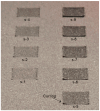Support-Free Low-Temperature Laser-Based Powder Bed Fusion of Polymers Using a Semi-Sintering Process
- PMID: 39684023
- PMCID: PMC11644373
- DOI: 10.3390/polym16233278
Support-Free Low-Temperature Laser-Based Powder Bed Fusion of Polymers Using a Semi-Sintering Process
Abstract
In conventional laser-based powder bed fusion of polymers (PBF-LB/P), aging of the powder due to preheating of the powder bed is a significant issue. This paper proposes a method for low-temperature PBF-LB/P using a semi-sintering process that minimizes powder aging caused by preheating. By partially semi-sintering the low-temperature powder bed, it was possible to execute the PBF-LB/P while avoiding the aging of most of the powder. Furthermore, the suppression of curling by the semi-sintered body eliminated the need to connect the base plate to the parts, which was necessary in previously reported low-temperature PBF-LB/P. Using the semi-sintering process, we successfully built cuboid and tensile test specimens in a polyamide 11 powder bed maintained below the crystallization temperature, where the powder hardly aged. The apparent densities of the built specimens were comparable to those produced using high-temperature PBF-LB/P. However, the elongation in the building direction of the built parts by the semi-sintering process should be improved. This study represents the first step toward the practical application of low-temperature PBF-LB/P using semi-sintering.
Keywords: laser sintering; low-temperature powder bed fusion; semi-sintering.
Conflict of interest statement
The authors declare no conflicts of interest.
Figures


















References
-
- Han W., Kong L., Xu M. Advances in Selective Laser Sintering of Polymers. Int. J. Extreme Manuf. 2022;4:042002. doi: 10.1088/2631-7990/ac9096. - DOI
-
- Bryant J.S., Bortner M.J., Williams C.B. Powder Bed Fusion Additive Manufacturing of Ultra-High Molecular Weight Polyethylene Using a Novel Laser Scanning Strategy. Addit. Manuf. 2024;79:103885. doi: 10.1016/j.addma.2023.103885. - DOI
-
- Ghita O.R., James E., Trimble R., Evans K.E. Physico-Chemical Behaviour of Poly (Ether Ketone) (PEK) in High Temperature Laser Sintering (HT-LS) J. Mater. Process. Technol. 2014;214:969–978. doi: 10.1016/j.jmatprotec.2013.11.007. - DOI
-
- Chatham C.A., Long T.E., Williams C.B. Powder Bed Fusion of Poly(Phenylene Sulfide)at Bed Temperatures Significantly below Melting. Addit. Manuf. 2019;28:506–516. doi: 10.1016/j.addma.2019.05.025. - DOI
-
- Schmid M. In: Laser Sintering with Plastics. Julia D.L., editor. Carl Hanser; Munich, Germany: 2018.
Grants and funding
LinkOut - more resources
Full Text Sources

